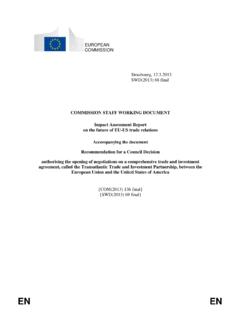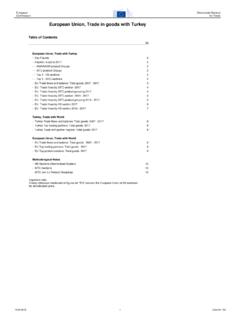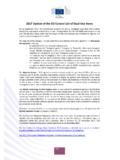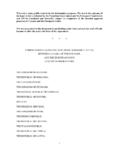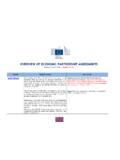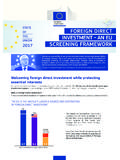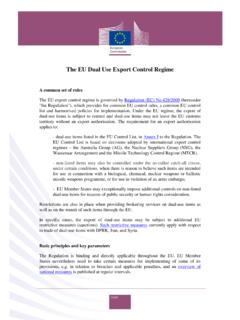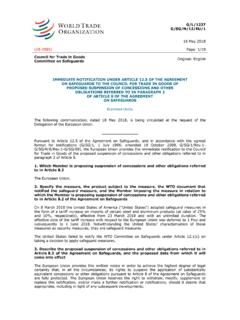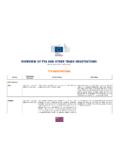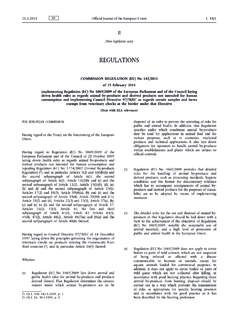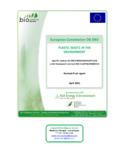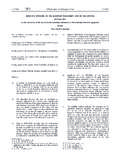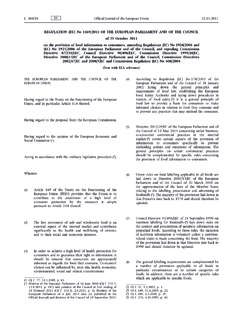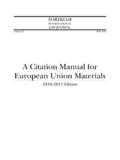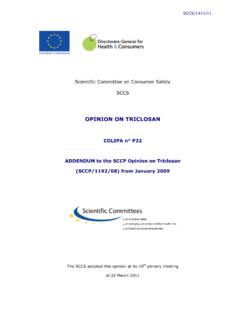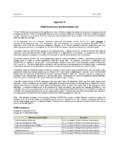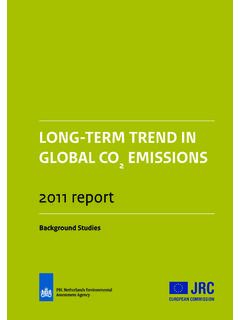Transcription of Annual Report on the Implementation of the EU-Korea Free ...
1 EN EN european commission Brussels, COM(2016) 268 final Report FROM THE commission TO THE european PARLIAMENT AND THE COUNCIL Annual Report on the Implementation of the EU-Korea Free Trade Agreement {SWD(2016) 162 final} 2 Report FROM THE commission TO THE european PARLIAMENT AND THE COUNCIL Annual Report on the Implementation of the EU-Korea Free Trade Agreement 1. Introduction 1 July 2015 marked the fourth anniversary of the Free Trade Agreement (FTA) between the EU and its Member States and the Republic of Korea ( Korea ). The FTA has been provisionally applied since July 2011. On 13 December 2015, it entered formally into force following the ratification by EU Member States. The EU-Korea FTA is the first of a new generation of FTAs, characterised by its far-reaching and comprehensive nature. It is also the EU's first trade deal with an Asian country and the most ambitious FTA implemented by the EU so far.
2 The FTA has already seen its first amendment. The Additional Protocol to the FTA to take into account Croatia s EU accession was signed in March 2014 and provisional application started on 26 May 2014. It entered into force on 1 January 2016. This is the fourth Annual Report on the Implementation of the FTA, in accordance with the provisions of Regulation (EU) No 511/2011 of the european Parliament and of the Council of 11 May 2011 implementing the bilateral safeguard clause of the Free Trade Agreement between the european Union and its Member States and the Republic of Korea1. According to Article 13(1) of the said Regulation, the commission shall make public an Annual Report on the application and Implementation of the Agreement. Furthermore, Article 3(3) stipulates that the commission shall present an Annual monitoring Report to the european Parliament and the Council on updated statistics on imports from Korea of products in the sensitive sectors and those sectors to which monitoring has been extended.
3 This Report therefore combines these two reporting requirements. The evolution of EU imports from Korea in the sectors covered by the monitoring and the results of the specific monitoring on duty drawback are presented in the commission Staff Working Document attached to this Report . The Report also gives an overview of the activities of the various committees and working groups established under the FTA to monitor the Implementation of the agreement. Since most of these met in the second half of 2015, this Report covers the period July 2014 until December 2015. The analysis of trade statistics covers the fourth Implementation year, July 2014 to June 2015 to allow for a comparison with the corresponding 12-month period before the FTA took effect, whereas the summary of the activities of the FTA Implementation bodies covers the calendar year 2015. 1 OJ L 145, , p.
4 19 3 2. OVERALL ASSESSMENT: EVOLUTION OF TRADE AFTER FOUR YEARS OF FTA Implementation Methodology used for the analysis The below analysis of the bilateral trade flows for goods between the EU and Korea is based on a comparison of data for the fourth year of Implementation of the FTA (July 2014 June 2015) with the 12-month period before the FTA took effect and provisional application started (July 2010 June 2011). As regards trade in services, the analysis is based on Annual data until 2014. It should be noted that changes in trade flows cannot be attributed solely to the FTA, as also other factors influence trade flows. However the figures provided below give a good indication of how the FTA has worked so far. Overall evolution of trade in goods EU exports to Korea increased by 55%, from billion EUR in the 12-month period before the FTA took effect to billion EUR in the fourth year of the FTA. The Annual increase in exports was more than 15% in the first year of FTA implementation2, 8%-9% in the second and third years and 14% in the fourth year.
5 EU exports to Korea of products that were fully or partially liberalised by the FTA grew by 57% and 71% respectively compared to the 12-month period before the FTA took effect (by billion EUR and billion EUR respectively), whereas EU exports of products subject to zero MFN tariff grew by 25% ( billion EUR). The respective growth of EU exports to the world3 of these products was 19% for the fully liberalised products, 26% for the partially liberalised products and 13% for the zero MFN products. Graph 1: EU Exports to and Imports from Korea, July 2010-June 2015 (billion EUR) 2 First year of FTA Implementation (July 2011-June 2012), second year (July 2012-June 2013), third year (July 2013-June 2014), fourth year (July 2014-June 2015). 3 This refers to extra-EU trade only, trade with EU Member States is excluded. 4 Source: EUROSTAT-COMEXT (extracted in October 2015) EU imports from Korea in the fouth year of the FTA amounted to billion EUR, having increased by 5% since the 12-month period before the entry into effect of the FTA.
6 In the third and fourth years of Implementation , imports increased annually by 6%, whereas in the second year they decreased by 6% compared to the previous year. It is worth noting that in the fourth year of FTA Implementation , EU imports from Korea increased more than EU imports from the world, which increased by 2% compared to the previous year. EU imports from Korea of products that were fully or partially liberalised by the FTA grew by 35% and 64% respectively compared to the 12-month period before the entry into effect of the FTA (by billion EUR and billion EUR respectively), whereas EU imports from Korea of products subject to zero MFN tariff decreased by 29% (by billion EUR). Overall, the EU's billion EUR trade deficit with Korea in the 12-month period before the FTA took effect has turned into a trade surplus, amounting to billion EUR in the fourth year of the FTA.
7 The EU's share in total Korean imports increased from 9% before the entry into effect of the FTA to 13% in its fourth year. Over the same period of time, the EU's share in total Korean exports declined from 11% to slightly less than 9%4. Sectoral effects In terms of EU exports, the most important product categories are: "Machinery and appliances" (HS5 16), accounting for 30% of total EU exports to Korea, which increased by 24%. "Transport equipment" (HS 17), representing 21% of total EU exports to Korea, which increased by 134%. "Chemical products" (HS 06), accounting for 12% of total EU exports to Korea, which increased by 21%. Other categories of products that have shown a significant increase in EU exports since July 2011 are "Mineral products" (HS 05)6), "Pearls & precious metals" (HS 14), "Footwear" (HS 12) and "Wood" (HS 09). The current level of EU exports to Korea would have generated duty payments of billion EUR had the FTA not been in place7.
8 4 The EU's share in total Korean imports refers to Korea's imports from the EU as a share of Korea's imports from the world. The EU's share in total Korean exports describes Korea's exports to the EU as a share of Korea's exports to the world. 5 Harmonised system 6 EU exports of "Mineral products" to Korea increased mainly in the first year of FTA Implementation . They account for 7% of total EU exports to Korea. 7 This calculation is based on Korean imports from the EU at HS6 level, in the fourth year of the FTA Implementation (ITC data). 5 As far as EU imports from Korea are concerned, the main product categories are: "Machinery & appliances", accounting for 36% of EU imports from Korea, which decreased by 16%. "Transport equipment", accounting for 26% of total EU imports from Korea, which fluctuated over the four years and in June 2015 were almost at the same level as in June 2011.
9 Significant increases were noted in EU imports of "Chemical products" and "Plastics" (HS 07), which have increased by 115% and 59% respectively since the FTA's entry into effect. Bilateral trade of motor vehicles and car parts EU exports of motor vehicles (HS 8703) have increased by 206%, from billion EUR (74,600 units) in the 12-month period preceding the entry into force of the agreement to billion EUR (210,900 units) in the fourth year of the FTA, accounting for 13% of total EU exports to Korea. The Annual increase in exports was around 35% in the second and third years of the FTA, whereas in the fourth year it was 61%. EU imports from Korea have grown by 53% from billion EUR to billion EUR or by 13% in terms of units imported (from 300,000 to 339,000). The entire increase (53%) occurred in the first year of FTA Implementation . Motor vehicles account for 10% of total EU imports from Korea.
10 Graph 2: EU Exports to and Imports from Korea of Motor Vehicles, July 2010-June 2015 (billion EUR) Source: EUROSTAT-COMEXT (extracted in October 2015) 6 EU exports of car parts to Korea8 were around billion EUR in the fourth year of the FTA, having increased by 18% since the 12-month period before the FTA took effect. The highest Annual increase (12%) occurred in the fourth year of FTA Implementation . EU imports from Korea of car parts increased by over 36% from billion EUR in the 12-month period before the FTA took effect to billion EUR during the fourth year of the FTA. The 23% increase in imports in the first year of the FTA was followed by a 13% decrease in the second year and a 12% Annual increase in the third and fourth years. Trade in services and Foreign Direct Investment (FDI) In 2014 EU exports of services amounted to billion EUR, having increased by 11% compared to the previous year.

